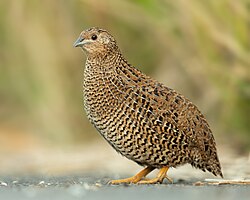| Synoicus | |
|---|---|
 | |
| S. ypsilophorus | |
 | |
| S. chinensis | |
| Scientific classification | |
| Kingdom: | Animalia |
| Phylum: | Chordata |
| Class: | Aves |
| Order: | Galliformes |
| Family: | Phasianidae |
| Tribe: | Coturnicini |
| Genus: | Synoicus Gould, 1843 |
| Type species | |
| Tetrao ypsilophorus Bosc, 1792 | |
| Species | |
See text | |
| Synonyms | |
Synoicus is a genus of 4 species of Old World quail. [1]
The species in the genus are distributed throughout sub-Saharan Africa, tropical Asia, and Australasia. Two of the four species in the genus were originally classified in Excalfactoria, one was classified in Anurophasis , and one was classified in Coturnix . Several phylogenetic studies found these species to all group together into a single genus, which was followed by the International Ornithological Congress in 2021. [1] [2] [3] [4]







